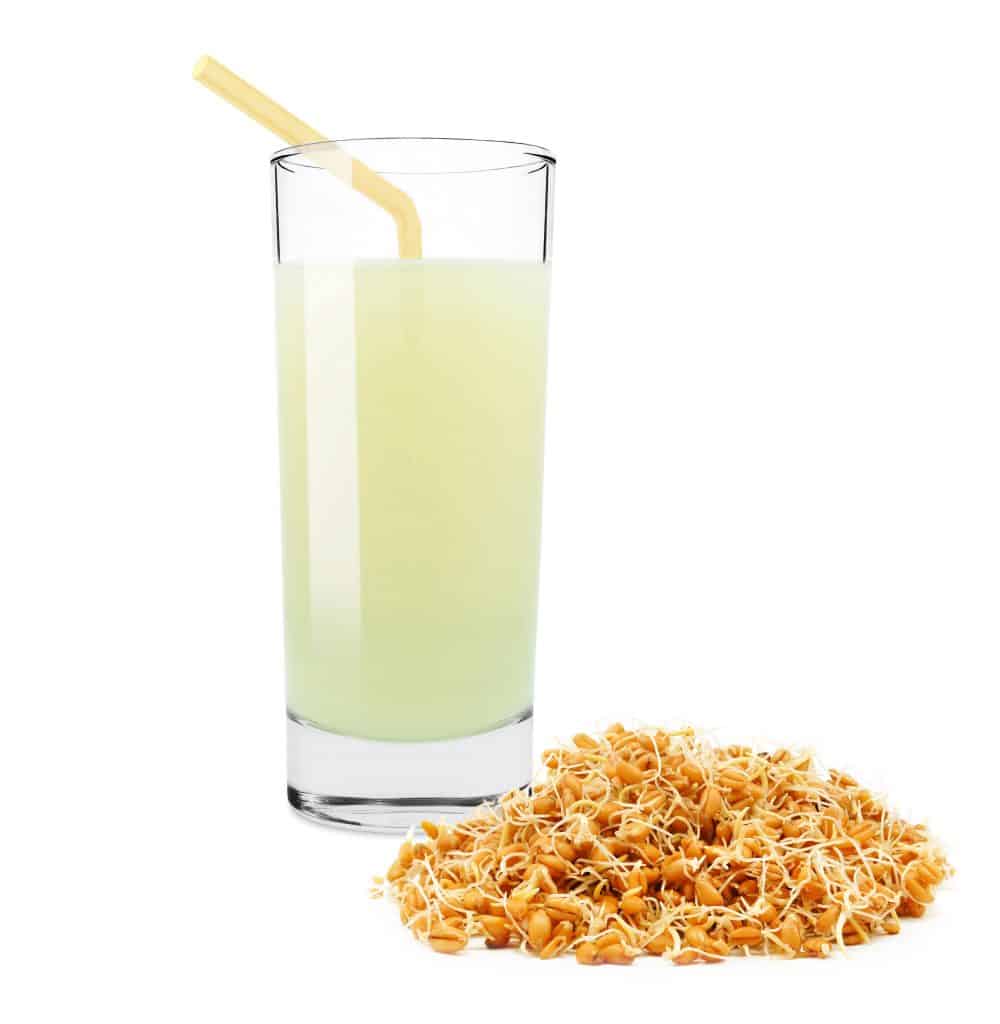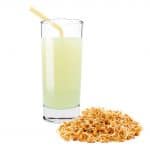
Rejuvelac is a refreshing, healthy, fermented drink made from grains (or sprouted grains) such as rye, barley, oats, or wheat berries.
Depending on the kind of grains used as well as the time of fermentation, rejuvelac acquires a lemony-cheesy flavour. A word of caution here: not many people find rejuvelac’s taste palatable – it certainly can take some getting used to.
Many people add rejuvelac to salads, dressings, dips, soups, stews, broths, and condiments to enhance the flavours. But most people simply drink a small glass of rejuvelac between meals to improve digestion, prevent acidity, and give a boost to their immune system.
Table of Contents
What are sprouted grains?
The process of sprouting grains wakes up the dormant seeds and turns them into little powerhouses of energy and nutrition.
Sprouted grains are fast becoming a health trend that is here to stay: they are fun to grow and eat and a delicious way to add nutrition to one’s diet.
Sprouted grains are high in fiber and protein and can be easily added to any dish to make it tastier and more nutritious.
Benefits
Ann Wigmore, the pioneer in the development of Rejuvelac as well as the ‘sprouting revolution’ believes that ‘when we eat a sprout, we are eating a tiny nutritional plant that is at its peak of nutritional value’. A sprouted seed releases its stored nutrients in a burst of vitality as it attempts to become a full-sized plant.
Here are the potential wellbeing benefits of rejuvelac.
Suitable for everyone
Everyone can enjoy rejuvelac (or sprouted grains in general) in their daily diet. Sprouting can fit into any lifestyle and can be enjoyed by people following different diets. The elderly, vegetarians, athletes, and even busy people who are always on the go and do not get to eat right can also enjoy sprouts and reap its benefits.
You can also add rejuvelac in place of water in recipes. Rejuvelac is available in most health food stores and you can also, very easily, make it at home.
Rejuvelac energizes, cleanses, and detoxifies
Rejuvelac is thought to be able to remove toxins and heavy metals from the water while adding nutrients such as probiotics, enzymes, vitamins, and minerals to it. Its detoxifying properties may be beneficial to cancer patients who have undergone chemotherapy.
More and more health-conscious people are detoxifying regularly by drinking rejuvelac and many are even replacing their sugary energy beverages with this probiotic drink instead.
Improves digestion
There is a reason why so many people are sipping on rejuvelac in between meals. First of all, rejuvelac contains amino acids that enhance protein digestibility. It also provides the colon with fresh probiotic or healthy microflora. These help the body fight off the bad bacteria which impede digestion causing gas, flatulence, hyperacidity, and other digestive issues.
Rejuvelac contains beneficial strains of bacteria, yeast, and other good microbes that also positively benefit the immune system.
Uses of rejuvelac
As a tonic
With its probiotic benefits and nutrition-rich content, rejuvelac can be taken as a tonic on a daily basis. It is rich in L.acidophilus, L.bifidus, and lactic acid. Having a tangy, lemony flavor, it is a delicious alternative to store-bought probiotic supplements.
As a cheese starter
Rejuvelac is a great natural starter for nut cheeses.
In soups and broths
With its tangy, cheesy flavour, rejuvelac can enhance the taste of soups, broths, and salad dressings. In fact, you can use it as a substitute for water in many recipes.
Potential side effects
If the rejuvelac fermentation process is followed properly, people should not experience any unwanted side effects after drinking this nutritious drink.
Store-bought rejuvelac can go bad after a few days. Remember: good quality rejuvelac tastes somewhere in between carbonated lemon water and liquid whey obtained after making yogurt.
Bad quality or spoilt rejuvelac has a putrid odour and taste and you must discard it right away. In general, rejuvelac has the ability to protect itself from bad or harmful bacteria. So, with careful preparation, it is completely safe to drink.
Some people experience mild side effects like stomach upset, diarrhea, gas, and nausea after drinking rejuvelac. But most have been able to tolerate it well. In fact, regular consumption of rejuvelac should reduce gas, nausea, bloating, and other digestive issues in most people.
Print
Rejuvelac Recipe
- Total Time: 10 minutes
- Yield: 3 cups per batch 1x
Description
This rejuvelac recipe uses un-sprouted grains but many people feel that unsprouted grains lend it an unpleasant flavour. So, you will find many recipes of rejuvelac using sprouted grains, especially sprouted wheat berries. You can experiment with both: sprouted and unsprouted grains. Proponents of sprouted recipes feel that sprouting gives the drink a better flavour that will remind you of lemons and cheese.
Ingredients
- 1 cup wheat berries
- 3 cups filtered or spring water
- Glass jar with wide mouth
- Freshly cut wheatgrass (optional)
Instructions
- Wash and scrub the wheat berries under tap water. Remove residue if any. The dead seeds or berries will float to the top. Discard them as they do not promote fermentation.
- Now you have to soak the berries for at least 2 days. This process will soften them.
- Place freshly cut wheat grass on top of the water used for soaking. You can remove this wheat grass each day when you filter the rejuvelac. Replace it with freshly cut wheatgrass.
- After 2 days, filter the rejuvelac. It can be used up that day, either for cooking or drinking. You can keep it at room temperature for about a day.
- Pour another 2 cups of filtered water in the jar and allow it to ferment for one day only. Pour and use the rejuvelac that day for cooking or drinking.
- Repeat these 1-day (24 hours) fermentation cycles twice. This means, you can soak each batch of wheat berries for a total of 3 times.
Notes
Use a cool, dark place for fermentation. The ambient temperature of the place where you keep your jar is an important factor in this process.
In the summer months, you can reduce fermentation times. During summer you can soak the seeds for 36 hours instead of 48 hours and then do 2 more cycles of 16 hours instead of 24 hours.
Experiment making rejuvelac with sprouted grains. You can also vary the grains and use millets, oats, rice, barley, rye, or buckwheat.
The basic recipe of rejuvelac is very simple: 1 part organic seeds and 3 parts filtered water or spring water. Fermenting time remains the same for all seeds.
Use organic seeds only as far as possible so that there are no traces of chemicals. Squeeze half a lemon or lime in the rejuvelac for additional flavour.
Lemon/lime juice will also act as a preservative and help the rejuvelac last longer. Use the spent seeds or grains to bake ‘live breads’.
- Prep Time: 10 minutes
How to store rejuvelac
Pour the rejuvelac in a clean glass jar and keep it covered in the refrigerator for up to 3 days.
The liquid tends to gather scum on the top and develops a cheesy odour, so don’t be alarmed.
The first batch of rejuvelac will have a stronger cheese-like taste and odour. The second and third batches will have a milder flavour, not unlike the whey in yogurt or cheese.
Conclusion
Rejuvelac is a healthy drink with tons of probiotic goodness. You can cook with it, drink it as a tonic, and it may even help improve immunity and digestion. Try out the rejuvelac recipe given above and enjoy its delicious tangy flavour!

Leave a Reply